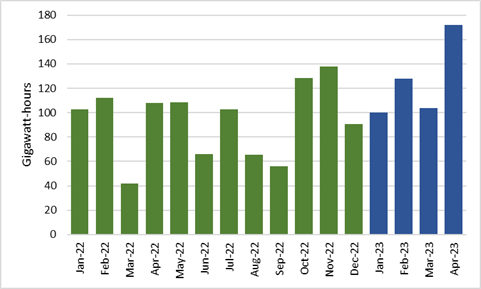Nova Scotia Power and the elusive 40 percent renewable electricity standard
Larry Hughes, PhD
30 May 2023
In early May, Emera released its first-quarter results for 2023. In keeping with recent practices, the results for Nova Scotia Power were presented in a separate document.
These results did not hold any major surprises, until that is, Emera CEO Scott Balfour made a couple of comments about the Maritime Link which were reported in AllNovaScotia.com.
"Nova Scotia Power customers have already received more than one million megawatt-hours of clean hydro energy over the Maritime Link."
This is quite true.
2022 was the first year a steady volume of electricity flowed from Newfoundland and Labrador to Nova Scotia over the Maritime Link. By the end of year, the Link had met about 1,119 gigawatt-hours (1.12 million megawatt-hours) of Nova Scotia Power's electricity demand.
However, you would never have known this from the company's 2022 quarterly reports. Supplies over the Maritime Link were lumped in with Nova Scotia Power's other purchases of renewable electricity.
Fortunately, the volumes transmitted over the Link in 2022 are available from the Newfoundland and Labrador Board of Commissioners of Public Utilities website.
And in a reversal of their past practice, Nova Scotia Power is now making the volume sent over the Link public because it is listed in the first quarter results for 2023.
However, Mr. Balfour was later quoted as saying that, "I'm pleased to say that with the flows of energy from the block this year continuing to stabilize and increase, Nova Scotia Power's energy supply year-to-date has exceeded the 40 percent renewable requirement."
Mr. Balfour's remarks made little sense when compared with Nova Scotia Power's first quarter results.
In the first quarter of 2023, Nova Scotia Power supplied its customers with 3,131 gigawatt-hours of electricity. Of this, 1,161 gigawatt-hours were from renewable sources (including 316 gigawatt-hours from the Maritime Link).
In other words, in the first quarter, 37.1 percent of the electricity Nova Scotian's used came from renewable sources.
That means if Mr. Balfour's 40 percent number is correct, something must have changed over the past few months.
Brace yourself.
In April of this year, the Labrador-Island Link (LIL) was finally commissioned by Newfoundland and Labrador Hydro.
The Labrador-Island Link is carrying increasing volumes of electricity from Muskrat Falls without failing.
With more electricity flowing from Muskrat Falls than ever before, Newfoundland and Labrador Hydro can send more electricity to Nova Scotia Power over the Maritime Link.
How much more?
As the following figure shows, the Maritime Link carried 172 gigawatt-hours of electricity in April 2023. The volume transmitted in the first four months of 2023 (504 gigawatt-hours) was almost equal to that in the first six months of 2021 (538 gigawatt-hours).

Monthly electricity volumes across the Maritime Link from Newfoundland and Labrador to Nova Scotia (Data from Newfoundland and Labrador Board of Commissioners of Public Utilities)
Barring a repeat of the problems which bedeviled the Labrador-Island Link last year, this will mean Nova Scotia Power will finally be meeting the province's renewable electricity standard and providing its customers with 40 percent of their electricity from renewable sources.
This will let Nova Scotia Power add more renewables to its energy mix, bringing the province closer to its 2030 target of 80 percent of electricity sales from renewable electricity sources.
Plus, it will stop the province from levying another $10 million fine on the company for not complying with the 40 percent sales requirement.
With the eastern side of the Atlantic Loop apparently working, now all Mr. Balfour needs is help from the federal and Nova Scotia governments, and the availability of electricity from Hydro Québec to get the western side working.
Published: AllNovaScotia.com 30 May 2023